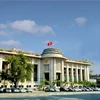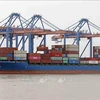From the beginning of this year, investments in resort properties have shown signs of revival after the market crash of 2008, and this led to huge excitement among big developers.
Localities with rich tourism potential are receiving massive investment inflows from real estate giants and witnessing vigorous changes.
However, the difference this time, from what was witnessed before the 2008 bust when most such projects along the country's central coast were with foreign developers, is that many beachfront resort projects are now in the hands of domestic developers who are becoming more active in the real estate market.
In recent years, big names including the VinGroup, FLC, the BIM Group, and the CEO Group in addition to the Sun Group have poured a significant amount of funds into developing resorts in popular cities and provinces with tourism potential, such as Phu Quoc, Nha Trang, Da Nang and Vung Tau.
The investment wave was seen to surge in the country's northern region in recent years with Quang Ninh, Hai Phong, Lao Cai and Thanh Hoa receiving huge investments for high-profile resorts.
What is remarkable is the rise in resort properties in Ha Long, the city of Natural World Heritage in Quang Ninh province, where a number of large-scale luxury resorts were being developed.
Along with the economic recovery, beachfront villas and townhouses are becoming a source of investment opportunities for the rich. The luxury resort property segment holds great potential given the new policy allowing foreigners to own houses from the beginning of July. The new policy is expected to trigger foreign capital inflow into the property market, especially in the high-end segment.
Statistics from the Boston Consulting Group show that some three million Vietnamese are now in the middle-class bracket, and they are financially capable of buying coastal property costing between 250,000 USD and 2 million USD per unit. The number of middle-class Vietnamese is expected to rise to 33 million by 2020.
According to Wealth-X, ultra-rich investors, not only from Asia but also Europe and North America, are showing interest in high-end resort properties in Southeast Asia, including Vietnam, which has great potential in sea tourism, with a coastline of more than 3,200 kilometres and thousands of islands.
Le Minh Dung, Executive Director of BIM Group's property business, said the rapid economic growth and rise in the tourist value of Quang Ninh province has given a boost to the resort property market here and the group, grasping the opportunities, has released several luxury commercial and resort property projects for sale in the past two years, including Little Vietnam and Van Lien (Lotus Residences).
According to Nguyen Nam Son, CEO of Vietnam Capital Partner, the urge to buy resort properties will intensify in the coming years as rich families are now eyeing such properties to earn profits from leasing them out and using them for their own relaxation by 2020.-VNA
Localities with rich tourism potential are receiving massive investment inflows from real estate giants and witnessing vigorous changes.
However, the difference this time, from what was witnessed before the 2008 bust when most such projects along the country's central coast were with foreign developers, is that many beachfront resort projects are now in the hands of domestic developers who are becoming more active in the real estate market.
In recent years, big names including the VinGroup, FLC, the BIM Group, and the CEO Group in addition to the Sun Group have poured a significant amount of funds into developing resorts in popular cities and provinces with tourism potential, such as Phu Quoc, Nha Trang, Da Nang and Vung Tau.
The investment wave was seen to surge in the country's northern region in recent years with Quang Ninh, Hai Phong, Lao Cai and Thanh Hoa receiving huge investments for high-profile resorts.
What is remarkable is the rise in resort properties in Ha Long, the city of Natural World Heritage in Quang Ninh province, where a number of large-scale luxury resorts were being developed.
Along with the economic recovery, beachfront villas and townhouses are becoming a source of investment opportunities for the rich. The luxury resort property segment holds great potential given the new policy allowing foreigners to own houses from the beginning of July. The new policy is expected to trigger foreign capital inflow into the property market, especially in the high-end segment.
Statistics from the Boston Consulting Group show that some three million Vietnamese are now in the middle-class bracket, and they are financially capable of buying coastal property costing between 250,000 USD and 2 million USD per unit. The number of middle-class Vietnamese is expected to rise to 33 million by 2020.
According to Wealth-X, ultra-rich investors, not only from Asia but also Europe and North America, are showing interest in high-end resort properties in Southeast Asia, including Vietnam, which has great potential in sea tourism, with a coastline of more than 3,200 kilometres and thousands of islands.
Le Minh Dung, Executive Director of BIM Group's property business, said the rapid economic growth and rise in the tourist value of Quang Ninh province has given a boost to the resort property market here and the group, grasping the opportunities, has released several luxury commercial and resort property projects for sale in the past two years, including Little Vietnam and Van Lien (Lotus Residences).
According to Nguyen Nam Son, CEO of Vietnam Capital Partner, the urge to buy resort properties will intensify in the coming years as rich families are now eyeing such properties to earn profits from leasing them out and using them for their own relaxation by 2020.-VNA



















